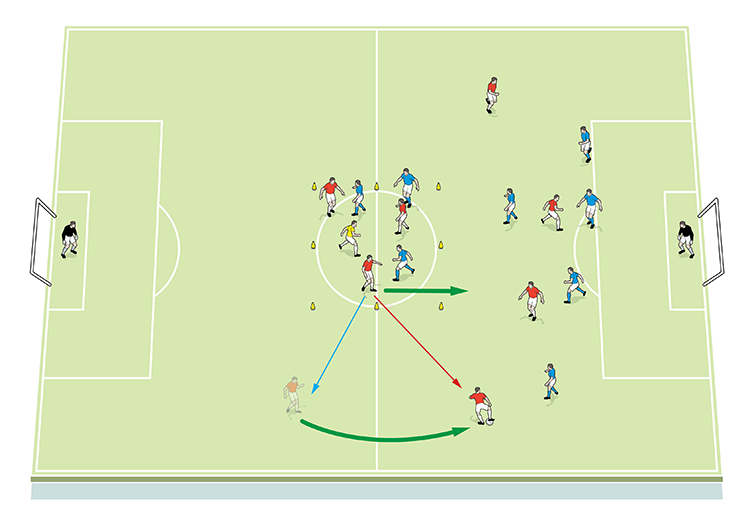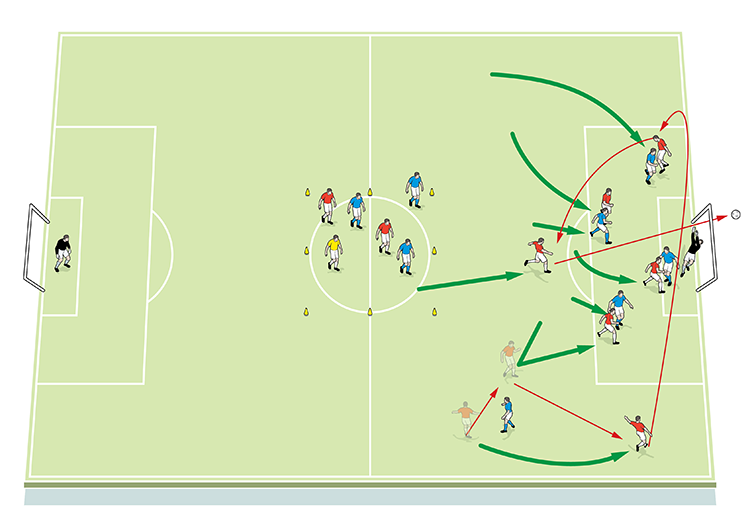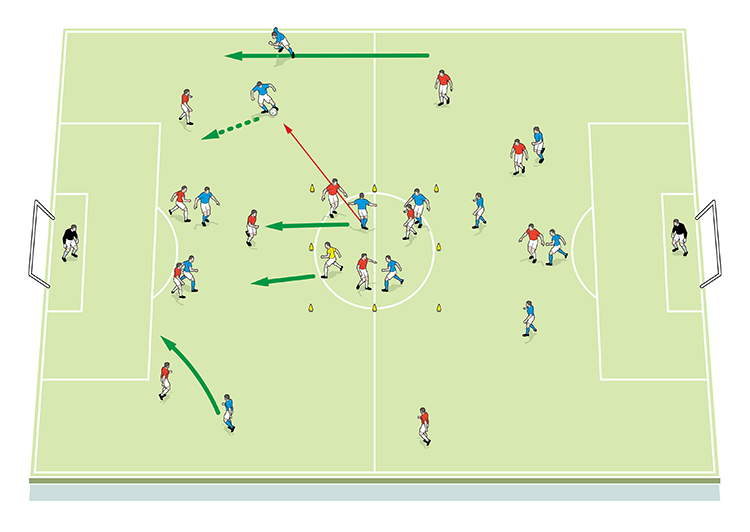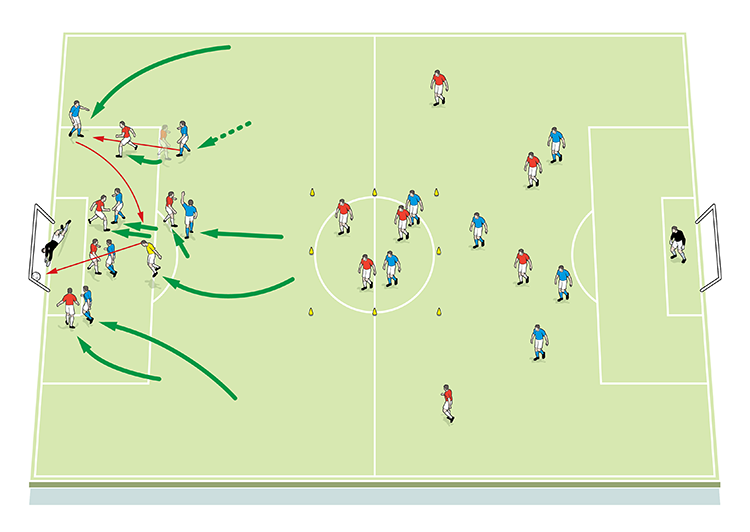You are viewing 1 of your 1 free articles
Winning the midfield battle
This session is about competing against opposition players in the middle of the park, and subsequently taking control of the game. It’s a session that relates directly to the cut and thrust of a match on a Saturday.
| Area | Full pitch |
| Equipment | Balls, cones, goals |
| No. of Players | Up to 12v12 plus keepers and floater |
| Session Time | 60mins |
This session is about competing against opposition players in the middle of the park, and subsequently taking control of the game. It’s a session that relates directly to the cut and thrust of a match on a Saturday.
If we were to do the same exercise in a box off the pitch, it would be a ‘keep ball’ session, yet by running the practice in the middle, central midfielders understand first-hand what they have to do to in order to control a game.
We’ll run this session in fine-tuning our approach for a couple of different scenarios - firstly, when going into a match where we expect a tight contest in the middle of the park. For instance, when playing against a team that likes to have three centre-midfielders.
Alternatively, it’s a useful practice to run when we might expect to be lining up with a 3v2 overload, for the fact it gets players used to taking advantage of the spare man in order to control possession and win the midfield battle.
What do I get the players to do?
The midfield battle
Setting up on a full size pitch, as shown (1a), we mark out a 20x20-yard area around the centre circle. In this area we set up a 3v3 (or 2v2) with a floater.
1a

The attacking side organises with two full-backs, two wingers and two strikers, while their opponents have a back four and a holding midfield player.
The session will start with the coach feeding the ball into the attacking three midfield players. The aim is to complete five passes between themselves before passing to either side. The midfielder who plays the pass will then break forward to support the attack. Whoever receives the ball will then play a 2v1 against the defender.
In playing out the move, we encourage the full-back to get forward and make an overlapping run. The aim is to feed the ball into the two strikers or the attacking midfielder to score a goal (1b). In addition, and as you would expect, the opposite winger should be encouraged to attack at the far post.
1b

How do I progress the session?
This exercise can then be turned into a match with the same principle. The ball is fed into the centre by the coach, with the first team completing five passes able to turn out and start an attack.
The coach can then allow the floater (or a second midfielder) to break forward and join the attack, creating an overload as the session goes on (2a). The remaining midfielders will sit in, ready to start again.
2a

To progress further, we will take the cones out and play a full match, retaining the same principles already outlined. So that means continuing to work with the midfield by feeding the ball in to a central midfielder on either team and encouraging players to stick to the passing and movement patterns already rehearsed.
2b

What are the key things to look out for?
The key for this to work is in moving the ball quickly in the middle of the park, and using the spare man to keep possession. It’s also crucial that when the opportunity to get the ball wide is available, play goes out with a quality pass, provoking others to join the attack.
Defensively, we’re looking for the midfield three to get tight to their men, thus making it difficult for them to keep possession and play it out wide.
Once the ball does go out wide, we’re looking for attackers to play direct and, of course, score goals.
Related Files
Editor's Picks
Deep runs in the final third
Using the goalkeeper in build-up play
Pressing principles
Intensive boxes drill with goals
Penetrating the final third
Creating and finishing
My philosophy
Pressing initiation
Compact team movement
Coaches' Testimonials

Alan Pardew

Arsène Wenger

Brendan Rodgers

Carlos Carvalhal

José Mourinho

Jürgen Klopp

Pep Guardiola

Roy Hodgson

Sir Alex Ferguson

Steven Gerrard
Coaches' Testimonials

Gerald Kearney, Downtown Las Vegas Soccer Club

Paul Butler, Florida, USA

Rick Shields, Springboro, USA

Tony Green, Pierrefonds Titans, Quebec, Canada
Join the world's leading coaches and managers and discover for yourself one of the best kept secrets in coaching. No other training tool on the planet is written or read by the calibre of names you’ll find in Elite Soccer.
In a recent survey 92% of subscribers said Elite Soccer makes them more confident, 89% said it makes them a more effective coach and 91% said it makes them more inspired.
Get Monthly Inspiration
All the latest techniques and approaches
Since 2010 Elite Soccer has given subscribers exclusive insight into the training ground practices of the world’s best coaches. Published in partnership with the League Managers Association we have unparalleled access to the leading lights in the English leagues, as well as a host of international managers.
Elite Soccer exclusively features sessions written by the coaches themselves. There are no observed sessions and no sessions “in the style of”, just first-hand advice delivered direct to you from the coach.









